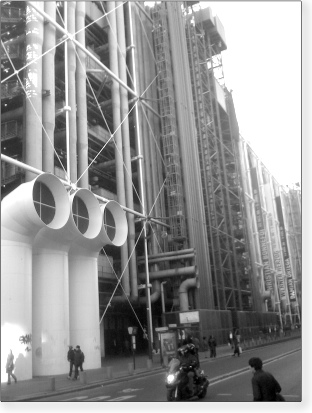Before we discuss the specifics of filling in truth tables, click here if the characters in your
truth tables do not look properly aligned in columns.
Completing a Truth Table
Upon selecting a truth table exercise, one is presented with an
incomplete truth table like this one:
The top line of the incomplete truth table contains the
statement letters contained in the argument, a vertical line, and
the sentence or argument for which the truth table is to be
constructed. The next line contains a separator -- basically a row
of hyphens and a single vertical line. Beginning on the third line,
beneath the statement letters appear the 2n
possible distinct truth value assignments that can be given for the
statement letters. (Because there is such a simple algorithm for
constructing these truth value assigments, we decided to relieve you
of the tedium of constructing them yourself -- but be sure you
know how to construct them on your own! You will need to know
how to to do this on your exams.) To complete each row correctly,
follow these two guidelines:
-
Enter a truth value (i.e., T or F) under
each logical operator.
-
Enter a truth value beneath an occurrence of a statement
letter if, and only if, that occurrence of the
statement letter is either one of the premises of the
argument or its conclusion .
Thus, following these guidelines a correct first row will look
like this:
Filling out each row in similar fashion, a completed truth
table will look something like this:
Clicking on the `Check Truth Table Now!' button will do just
that, i.e., it will check to see that you have filled in the truth
table correctly. If you have not, you should get a helpful
response telling you what went wrong, and a copy of your truth
table in a new box in which you can make the necessary
corrections.
Determining Validity
Once your truth table is correct, you will be presented with a
page that asks you to assess its validity. The relevant portion
of the page looks like this:
As noted in Section 7.3 of the text, to test for validity, you
look to see whether or not there is a row of the table on which
the premises of the argument are true and the conclusion false.
If you do not find such a row, the argument is valid, so click on
the `Valid' button to complete the exercise. If you have missed
such a row you will be so informed and presented with your errant
truth table for you to fix. If you do find such a row, check the
checkbox to its left, as indicated in our example:
You may then either click on the `Invalid' button (one row
with true premises and false conclusion is all you need to
establish invalidity) or you may continue to search for further
invalidating rows. If the row you check is invalidating, but you
miss further invalidating rows, the program will tell you your
answer is correct, but will give you the opportunity to find the
invalidating rows that remain. In either case, if you have
checked a row that does not invalidate the argument, you will
again be so informed and presented with your errant truth table.
If you are correct, enjoy the praise that will be heaped upon you!

|
The Power of Logic
Exercise 7.3A Problem 25
|
Correct!
|
You are correct! Row 3 shows that the argument is invalid! On this row of the truth table, the premises of the argument are true and the conclusion false. |
Your truth table:
A B | ~A -> (~B -> A), B :. ~~A
----|----------------------------
T T | F T F T T TF
T F | F T T T F TF
F T | T T F T T FT
F F | T F T F F FT
|
|
Appearance Problems in Netscape
If you are using Netscape, and statement letters, vertical bars, and
truth values (T's and F's) do not seem to be lining
up properly in columns, then Netscape is probably not paying attention
when it is being told to use a "nonproportional" font in a text area.
The problem is that Netscape by default likes to use a "proportional"
font in text areas, that is, a font whose characters come in different
widths. Thus, in a proportional font like Times or Helvetica, an "m",
for example, will usually be a lot wider than an "i" or a "-". To fix
this problem, click on the "Edit" menu option and then click on
"Preferences...". In the dialog box that comes up, click on the
little icon next to "Appearance" so you can see its suboptions, and
then click on "Fonts". Depending on whether you are using Netscape 4
or Netscape 6, do one of the following:
-
In Netscape 4, on the right side of the dialog box you should find
that the button next to the option to "Use my default fonts,
overriding document-specified fonts" has been clicked. Click on
either of the other options which begin "Use document-specified
fonts".
-
In Netscape 6, on the right side of the dialog box you will simply
find a checkbox option to "Allow documents to use other fonts". Check
that option.
This procedure should allow Netscape to obey when it is told to use a
nonproportional font, and hence should now render beautiful truth
tables!
|








